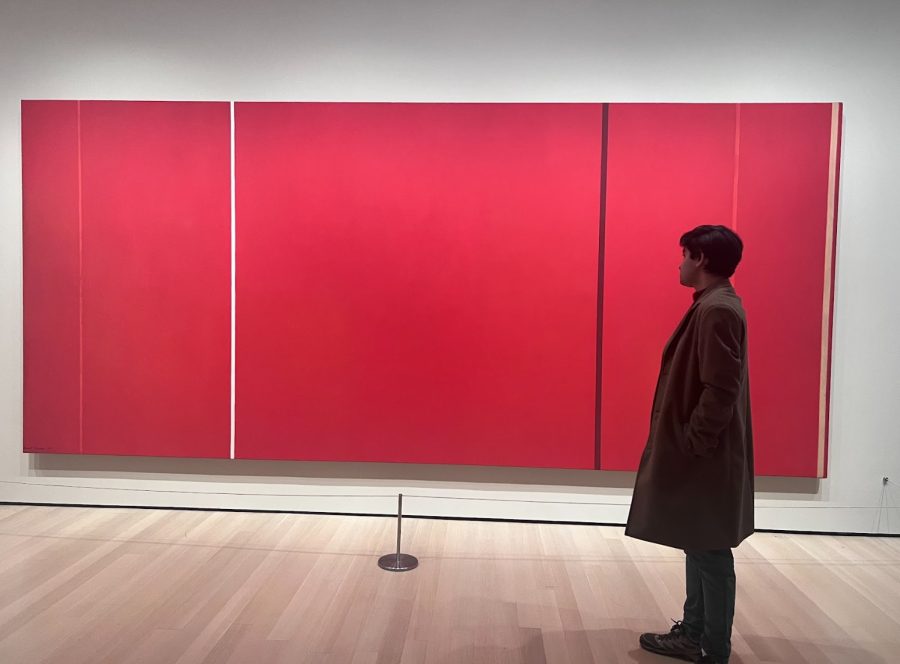I don’t like the term “Modern Art”. It really doesn’t mean anything. Does it mean work from the Impressionists in the late 1800s, the first major departure from the academic style of painting that came before it through Parisian Impressionist exhibitions? Does it mean the abstract “action painting” of Jackson Pollock or the social commentary of Andy Warhol’s prints? Is it that one banana taped to a wall, not to mention all the other sculptural work that goes beyond the bounds of two dimensions?
When someone says that they don’t like modern art, however, I get the distinct impression that they are referring to works created vaguely in the past forty years, broadly referred to as postmodern (for a variety of reasons I either don’t understand or do not want to argue about here). It is art that departs far and away from the careful realism and didactic function of High Renaissance art, often considered the “height” or “peak” of “real art” (whatever that means). Huge paintings of nothing but one or two colors, massive hunks of steel balanced on top of each other with seemingly no care or everyday objects placed on pedestals. Art that seems indecipherable or meaningless or so simple as to be worthless to look at, much less given any importance. I would like to argue here that this genre of art (if one could call it a genre, given its seemingly endless breadth and subject matter) is immensely valuable, even more so perhaps than what we consider “high art,” and it should be appreciated much more than it currently is.
I want to illustrate my love for this type of seemingly “meaningless” art with the story of one of my all-time favorite works of art, Barnett Newman’s “Who’s Afraid of Red, Yellow and Blue.” It has all the hallmarks of what can be considered the triteness and non-creativity of the modern art world. It is a series of huge paintings made with nothing but a huge swath of red with a short band of blue on the left and a shorter band of yellow on the right. What does that possibly mean? It’s just big colors on a big canvas; anyone could have done that. Why pay that any attention at all?
The story gets interesting when people who thought exactly that way decided to vandalize two of the paintings in the series by slashing across them with a knife. Some voiced their support for the act, but something strange happened once the painting was “restored.” Visitors noted that the areas that had been repainted looked “off” and “distracting.” If Newman’s work was truly just blocks of paint on canvas, what gives?
Turns out that Newman actually put thought into what he was doing. The artistry of the piece is not in his careful rendering of light and shadow on a nude figure or a still life or a great scene from the Bible or history. It is instead something arguably much harder: creating depths of color through the subtlety of paint. Newman uses all sorts of chemicals and materials to give his paint much more richness and texture than whatever you can buy at a store. He puts in meticulous effort to achieve these extremely vivid and eye-catching tones, and even the seemingly childlike composition of the colors next to each other all serve to elevate each individual color by contrasting so wonderfully with one another. The artistry comes through, not necessarily in any particular subject matter but in the wonders Newman is able to work with nothing but color in a way very few others are able to do. When you look at something and can’t figure out what it is or why it’s important, consider how difficult it is to replicate and how astounding the very process of creating art can be. In general terms, looking for non-obvious meanings of artwork can sometimes be much more rewarding than being given everything by the piece itself.
The words “I could have done that” get used a lot on pieces that are non-representational. I understand the instinct to say so when faced with works like Newman’s without knowing the requisite context. But also, you didn’t. You didn’t put in the effort to create something, even if it wouldn’t have taken you long to do so. The fact that someone else did, went through the process of doing so and has now had it displayed, should actually prompt you to consider what would make someone actually go through with something that seemingly “anyone could have done.”
There is also this idea that effort determines the value of a piece. I hope I’ve illustrated that even these seemingly simple artworks contain a lot of depth if you look just a little deeper (or read the museum label when you see it for context). But I’ll take it a step further and say this: it doesn’t matter. Effort and skill are pretty immaterial when you’re looking at a piece of art. If you told me that “A Starry Night” by Van Gogh actually only took him two hours, it would not diminish the sheer beauty of the painting at all. If Michelangelo carved “David” in a day, would that make the statue any less stunning? I argue that if one were to judge art, it would be by the emotions that it inspires in the viewer. If you look at a piece of art and it makes you feel something, I’d say that it has accomplished its goal.
This brings me to my next point: the emotions that art inspires can be wide-ranging and seemingly limitless. Painters in the Renaissance era who were influenced strongly by the Biblical canon painted scenes which evoke reverence and divinity. “A Starry Night” was based on the wonder that Van Gogh felt when looking at the night sky and all the stars in it. Let’s go back to that banana taped to a wall (a piece called “Comedian” by Maurizio Cattelan). It may make you angry knowing that it sold for over $100,000 or that it occupies space that better art could’ve taken. But anger, confusion and outrage are all emotions too, and emotions that this piece seems to consistently create in those who look at it. Viewed from this lens, that banana taped to a wall is more successful as art than a thousand hyper-detailed Renaissance-era biblical paintings. As an aside, that piece was created as a mockery of how absurd the art world can be at times, so Cattelan would probably agree with you in how stupid or odd it is that a banana taped to a wall sold for that much.
Diverging from this, capital-M “Modern Art” serves also as a democratization of art. To grossly oversimplify, the reason why impressionists made their own exhibitions is because of the standardization and regulation of art in formal Royal Academies that served to excessively gatekeep what art can or cannot be displayed. Before this point, it was only artists who had the favor of the academy, painted like everyone else and painted the same subjects as everyone else. They were quite often the same type of people: white male artists of certain social strata. This break from the Academic form of art led, in part, to some of the most recognizable artworks that we see today. Picasso, Van Gogh, Pollock and others all have some roots in that Impressionist urge to break away from the conformity of the Academies of Art and to blaze their own paths in the art world.
This rise in accessibility and transition away from a standardized method of painting meant that voices that were historically excluded from Academies, such as racial, gender and sexual minorities, now had a chance of entering the wider consciousness of the public via their art. They still faced massive social barriers in doing so, but I feel it is undeniable that the break from what is considered to be traditionally “high art” or “good painting” was the first step in including a much wider perspective and expression in art. Without it, would we have even gotten to see works from Jean-Michel Basquiat or Warhol or Jenny Saville? I find it difficult to imagine, personally.
My final point on the appreciation of modern art is that art, in large part, acts as a reflection of society and social conditions. That’s what I find so interesting about art history: how different places and people tell you about themselves through the implicit and explicit assumptions they make in their artistic styles and expressions. If you look at modern art and see nothing but disorder, chaos, confusion and a lack of meaning, maybe you should look around. The world is on the brink of multiple different crises, from climate change to the rise of fascism across the globe to ongoing wars and conflicts. There’s a move away from traditional religious dogma and a void in society that something has to fill, whether that’s nationalism, social democracy, socialism, technology or something else entirely. The world is kind of a mess right now, so why would the art made in such a mad world even remotely resemble what came before it? We live in the New Age, a time of limitless possibilities and limited time to fix what we have broken. The art made now may only be a reflection of this, the chaos we find in our daily lives and around the world.
The point of all this is not that you should like every modern artwork. Sometimes a piece simply does not resonate with you and inspires nothing but indifference. And that’s alright. There are some pieces of modern art that I personally cannot stand (looking at you, Rothko) or simply do not understand no matter how many times I bang my head against the wall the art may or may not be mounted on. But I hope that even one person reads this and is inspired to maybe take a second look at art that they may have dismissed out of hand and maybe even find something they can appreciate about it. That would be quite nice, don’t you think?












Ramona Jones • Oct 13, 2024 at 11:35 am
Loved the art tickle, pun intended. Once we took our young son, maybe 7, to a city with a few art galleries. He was done with each one after 5 minutes. He perked up only once when his dad told him there was a lot of money to be made in the rendering of a tomato soup can after we saw an Andy Dandy. Son lit up like an LED light. We all laughed. Now he’s grown up and I have time to go to art galleries and look at variety all over the web. It’s that smorgasbord of creativity keeping me going in difficult times.